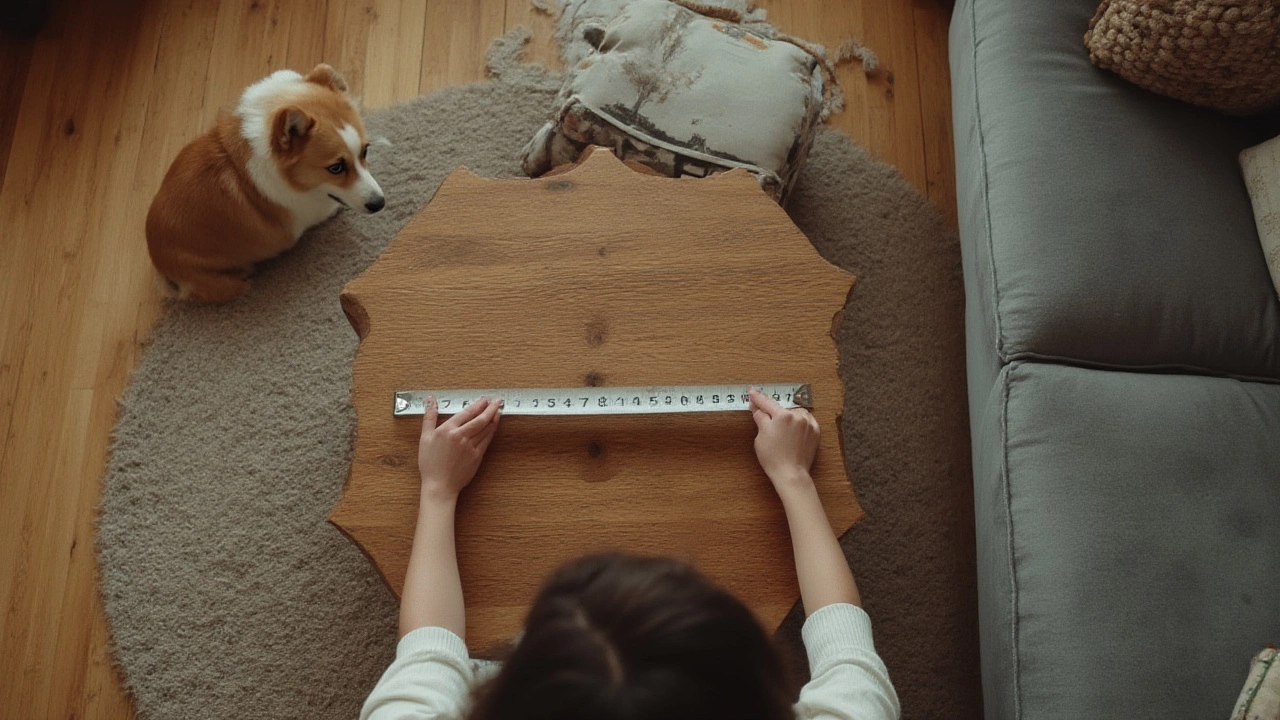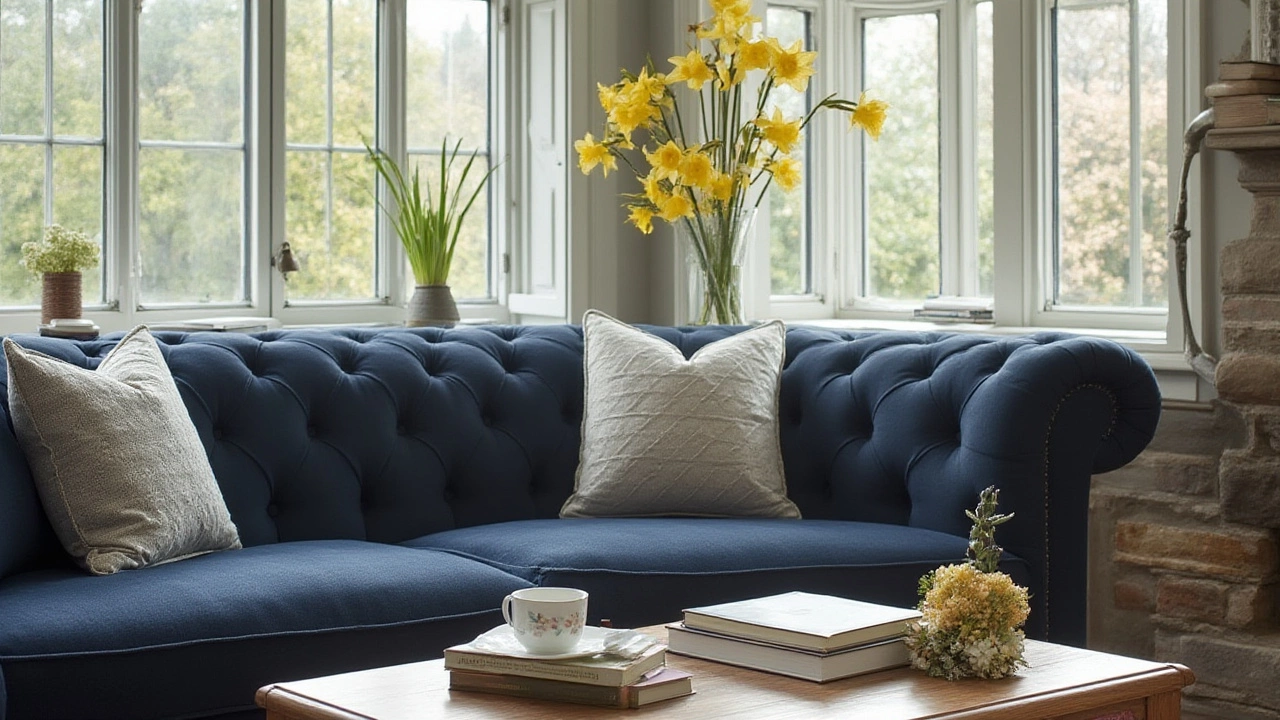Ever tried setting down a hot cup of coffee, only to awkwardly stoop over because your table’s the wrong height? Or maybe you’ve noticed your knees barely fit, making your living room feel weirdly uncomfortable. Picking the right coffee table height isn’t just a design detail—it’s something you feel every single day. Tiny differences can throw the balance off, and nobody wants an unintentional core workout just to put their mug down.
What Is the Standard Coffee Table Height?
The usual sweet spot for coffee table height is 16 to 18 inches (about 40 to 46 cm). Most sofas sit at roughly 17 to 19 inches from the floor to the top of the seat cushion, which means the classic approach is to keep your coffee table either level with or 1 to 2 inches lower than your couch seat. The idea is to keep things easy: you want to reach for snacks, books, or your phone without stretching or slouching. A table that’s level with the couch seat feels balanced and simply works with the flow of the room.
Manufacturers like IKEA and West Elm almost always stick within this general range. Of course, there are exceptions if you’re into low-slung, mid-century style, or have unique furniture dimensions. Some Japanese-inspired tables, for example, might dip closer to 12 inches. But, for the majority of living rooms in North America or Europe, the "normal" coffee table sits right around 16 to 18 inches tall.
Here’s a quick cheat-table so you don't have to guess:
| Sofa Seat Height | Best Coffee Table Height |
|---|---|
| 16" (40 cm) | 15–16" (38-41 cm) |
| 17" (43 cm) | 16–17" (41-43 cm) |
| 18" (46 cm) | 17–18" (43-46 cm) |
| 19" (48 cm) | 18–19" (46-48 cm) |
Notice how the difference is always just an inch or so—too much more, and you’ll either be reaching up awkwardly or bending down too low. That gets tedious fast, especially if you like to work, snack, or hang out at your coffee table.
Some people ask: "Should a coffee table ever be taller than my sofa seat?" Usually, no. If the table’s higher, it can look clunky next to your couch and even make serving or casual use feel off. There are exceptions—think behind-the-couch console tables or lift-top coffee tables meant for working, but for most living setups, you want the coffee table to sit even or just a little lower than your sofa seat.
How Table Height Shapes Your Space
It’s wild how that extra inch or two completely changes the vibe of a room. When a coffee table is just right, your living room looks put-together—like it’s meant to be there. If it’s too low, it shrinks the space, makes sitting awkward, and feels disconnected from the seating area. A table that’s too tall blocks sightlines, makes everything feel crowded, and, honestly, you’ll keep banging your knees.
The best height isn’t just about looks. It’s about how you use your living room. Do you have little kids who love to play on the floor? Lower tables can make coloring and board games way more fun for them (and less back pain for you). Are you tall, or does your family host lots of movie nights with snacks spread all over? A slightly higher table can make all the difference. The trick is noticing how you use your living room every day and letting those habits guide you.
People love open layouts, but when the coffee table is off, even the most beautiful space can lose its magic. Designers pay brutal attention to these little details. According to an interview with interior designer Emily Henderson, a table two inches too short can make your whole sofa area look just a bit off. That’s how much impact height has on proportions and how inviting your room feels. Want those Instagram-worthy interiors? It always starts with getting scale right—not squeezing in more throw pillows.
Ever heard of "visual weight"? A coffee table that’s too tall looks chunky and heavy, taking up mental real estate, while too short makes it feel like an afterthought. Your eyes are naturally drawn to things that feel out of proportion, like a tiny table next to an overstuffed sectional. You won’t be able to stop seeing it… until you fix it.
Even the most creative solutions, like nesting tables, only work well if they follow the general height rule. If you’re tempted by a unique piece at the flea market, measure your seating first and check those proportions before you commit.

Matching Coffee Table Height to Your Furniture (and Lifestyle)
Here’s where things get personal. The right table depends on the furniture you have and what you want in a living space. The old rule—table should be the same height or up to 2 inches lower than the seat—is a great starting point. But modern furniture throws some curveballs. Got a super deep, low-slung sectional or a high-armed vintage sofa? Neither follows “normal” proportions.
If you have a deep lounge couch (think those massive, cloud-like sofas everyone’s pinning online), you might actually need a table closer to 15 inches to match the super low profile. But for a classic tufted sofa with high seats, tables around 18 or even 19 inches might look better. Trust your eye, but always test it out—with an improvised stand-in table, a stack of books, or even a cardboard box—to see what feels right while you’re sitting on your couch.
Different lifestyles, different needs. If you have pets, you might want a higher table to keep snacks out of reach. Young kids? Rounded corners and a slightly lower profile help avoid injuries. Entertain often? Larger tables at standard height make passing snacks and drinks easy. Ever worked from your coffee table, maybe typing on your laptop or sketching out ideas? There are “lift-top” coffee tables that spring up a few inches for temporary desk duty. These are typically about 16-18 inches when closed and jump up to 21-24 inches open. Versatility comes at a price: not all lift-tops are sturdy, and many don’t look as smooth as a classic piece.
Here are some quick hacks to help you pick the perfect coffee table height for your space:
- Always measure your sofa’s seat height from the floor to the top of the cushion—use that as your main benchmark.
- If your room is small, opt for a shorter table—tall tables make tiny spaces look even more cramped.
- If you use your coffee table mostly for décor (think: books, candles), you have more leeway in height. If you use it actively (games, snacks, laptop), stick close to seat level.
- Don’t forget legroom—leave at least 16 to 18 inches between the edge of your sofa and the table so you can move comfortably.
- If in doubt, stack books or boxes to experiment with different heights before you buy anything.
Style matters too. Glass coffee tables are usually designed slightly lower, because the transparency keeps the look light. Wooden or chunkier tables can go higher without looking too beefy. Shape impacts perception—an oval table can look lower even if it’s the same height as a rectangular one, just because of the way curves trick the eye.
If you’re mixing materials, like a marble slab or metal frame, test how light bounces off—they sometimes appear bigger or taller than they really are. It’s all about lying to your eyes, but in a good way.
Helpful Facts, Shopping Tips, and Common Mistakes
Research from the American Home Furnishings Alliance shows that the coffee table height is the most common regret among living room furniture buyers, even more than color or shape. Turns out, you really notice when a table is too low or high—especially if you move homes or switch sofas and now your table looks like it belongs in another room.
Many retailers list coffee table heights right in the product name. If you see words like "cocktail table," you’re looking at a larger, usually wider table, but pay attention to height specs buried in the details. Websites may say “standard height,” but always double-check the actual measurement before clicking add to cart.
Pitfalls are everywhere: It’s easy to fall for trends—like super-low, wide tables that look cool on Pinterest but are totally impractical for your actual living room. Or super-high tables that claim to double as desks but leave you hunched over or feeling like you’re in a waiting room. Don’t assume that expensive means better: A $1,000 designer table could be the wrong height for your sofa. The best tip? Bring a measuring tape everywhere—take measurements at the store, then check them at home with furniture, including your rug (if you use one), since thick, fluffy rugs can zap half an inch off your table’s height.
If you’re into DIY, aim for adjustable legs or bases. Basic hardware stores now carry metal hairpin legs you can screw into vintage table tops and give yourself a custom height. Just leave room for error—measure twice, drill once, as my grandpa always said. Consider the weight tolerance if you go the DIY route, especially with kids or pets around who love to climb on tables. A little wobbly is funny until someone’s drink (or head) ends up on the floor.
Pay attention to context: If you love eating dinner at your coffee table during movie nights, you might want to break the normal height rule by an inch to make eating more convenient. On the other hand, if your living room is mostly for conversation and lounging, going lower helps keep everything relaxed and in balance.
Here’s a hot tip most people miss: Don’t forget to account for the thickness of your area rug under the coffee table. A thick shag can eat up an inch, making what you thought was the right height suddenly feel unmatched.
One last bit to chew on—style doesn’t have to suffer for comfort. Look at spaces designed by pros: They combine proportion, height, and personal quirks (maybe a special chessboard or favorite art book) to make the table work for how they live, not just for how the room appears online.
Your coffee table is the anchor of your living room, the spot where everything comes together, from morning coffee to late-night takeout and lazy Sunday puzzles. When you get the height right, it just clicks—you notice the room feels right, almost like you’ve always lived there. If you’re still in doubt, measure your sofa, stack up a few books, and see what feels best. You’ve got this.


Write a comment